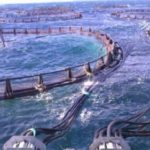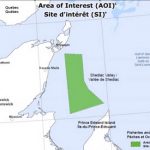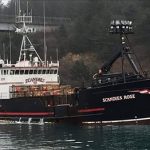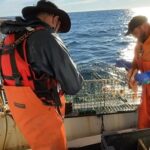Tag Archives: University of Maine Darling Marine Center
DMC researchers test technique to determine lobster’s age
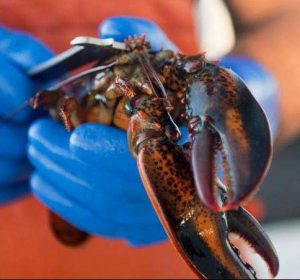 Research professor Rick Wahle and graduate student Carl Huntsberger are testing a technique at the University of Maine Darling Marine Center to determine the age of lobsters. Unlike fish, mollusks and trees, Wahle says lobsters and other crustaceans molt—or cast off their skeletons thereby discarding external signs of growth. That means a lobster’s age is estimated on size, but it’s a rough determination because ocean conditions affect the crustacean’s growth rate. Not knowing a lobster’s age is problematic for scientists and fishery managers seeking to measure the health of the fishery and the sustainability of the stock. Continue reading the story here 10:06
Research professor Rick Wahle and graduate student Carl Huntsberger are testing a technique at the University of Maine Darling Marine Center to determine the age of lobsters. Unlike fish, mollusks and trees, Wahle says lobsters and other crustaceans molt—or cast off their skeletons thereby discarding external signs of growth. That means a lobster’s age is estimated on size, but it’s a rough determination because ocean conditions affect the crustacean’s growth rate. Not knowing a lobster’s age is problematic for scientists and fishery managers seeking to measure the health of the fishery and the sustainability of the stock. Continue reading the story here 10:06
Researchers: Global Warming Could Wipe Out Maine Lobsters in 85 Years!
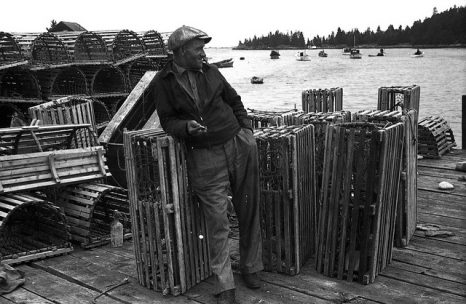 The Gulf of Maine is warming at an alarming rate. Research by the National Oceanic and Atmospheric Administration shows ocean temperatures are rising at three times the rate of global averages. This increase in temperatures is linked to the collapse of the New England cod population, and new research shows the fate of the Maine lobster is likely similar. A new report from the University of Maine Darling Marine Center and the Bigelow Laboratory for Ocean Sciences predicts the Maine lobster population will be wiped out by 2100 due to climate change. The study examined how lobster larvae are impacted by rising ocean temperatures and ocean acidification. Although acidification seems to have no significant impact on the larvae, warming temperatures are a different story. Lobsters reared in water that is 3 degrees Celsius warmer than current temperatures in the western Gulf of Maine had bleak survival rates. Read the rest here 11:51
The Gulf of Maine is warming at an alarming rate. Research by the National Oceanic and Atmospheric Administration shows ocean temperatures are rising at three times the rate of global averages. This increase in temperatures is linked to the collapse of the New England cod population, and new research shows the fate of the Maine lobster is likely similar. A new report from the University of Maine Darling Marine Center and the Bigelow Laboratory for Ocean Sciences predicts the Maine lobster population will be wiped out by 2100 due to climate change. The study examined how lobster larvae are impacted by rising ocean temperatures and ocean acidification. Although acidification seems to have no significant impact on the larvae, warming temperatures are a different story. Lobsters reared in water that is 3 degrees Celsius warmer than current temperatures in the western Gulf of Maine had bleak survival rates. Read the rest here 11:51
UMaine scientist – population size of scallops affects fertilization success
 Scallop gonads may seem like fun and games to Skylar Bayer given that her missing samples landed her on “The Colbert Report” in 2013. But scallops are no laughing matter to Bayer. “When I was deciding on a Ph.D. project to pursue, I chose to work on a species that is commercially important and relevant to people’s daily life,” says Bayer, who is based at the University of Maine Darling Marine Center in Walpole. “Giant sea scallops in Maine seemed extraordinarily relevant.” In 2015, Maine fishermen brought in 452,672 pounds of scallop meat valued at $12.70 per pound — the highest in years. But scallops haven’t always done well in Maine and beyond. In the 1990s, after huge reductions in multiple fishery landings, including giant sea scallops, NOAA regulators instituted large fishing closures to try to bolster groundfish stocks. After four years, scallop stocks had increased 14 times what they were prior to the closure. Seeking a similar success story, Maine followed suit in 2009 and instituted a three-year scallop fishing closure. Read the story here 10:38
Scallop gonads may seem like fun and games to Skylar Bayer given that her missing samples landed her on “The Colbert Report” in 2013. But scallops are no laughing matter to Bayer. “When I was deciding on a Ph.D. project to pursue, I chose to work on a species that is commercially important and relevant to people’s daily life,” says Bayer, who is based at the University of Maine Darling Marine Center in Walpole. “Giant sea scallops in Maine seemed extraordinarily relevant.” In 2015, Maine fishermen brought in 452,672 pounds of scallop meat valued at $12.70 per pound — the highest in years. But scallops haven’t always done well in Maine and beyond. In the 1990s, after huge reductions in multiple fishery landings, including giant sea scallops, NOAA regulators instituted large fishing closures to try to bolster groundfish stocks. After four years, scallop stocks had increased 14 times what they were prior to the closure. Seeking a similar success story, Maine followed suit in 2009 and instituted a three-year scallop fishing closure. Read the story here 10:38

































